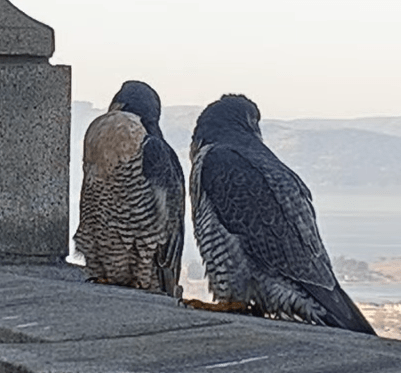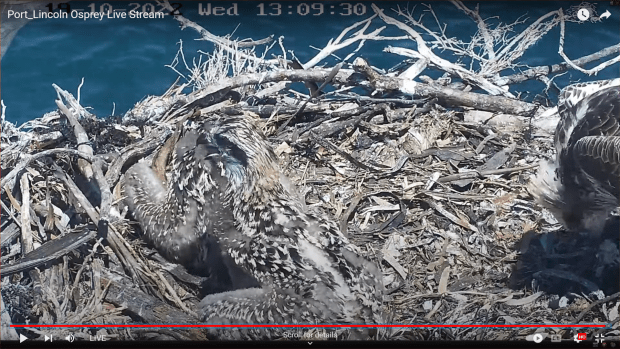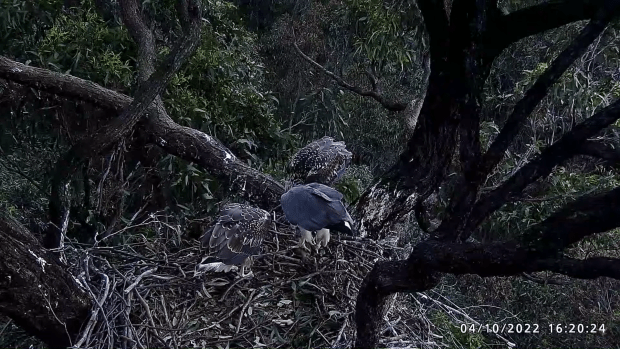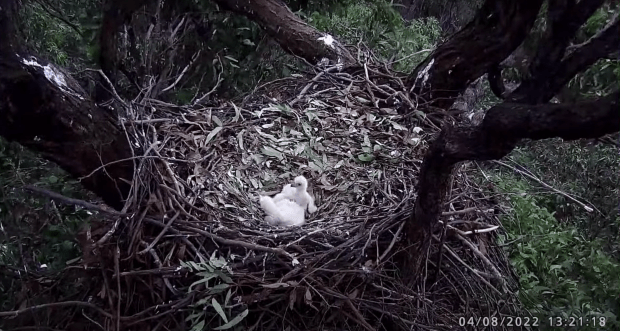21 November 2022
Oh, the best of the morning to all of you! I hope this newsletter finds you well and happy and taking some time to de-stress out of doors if you need it — or watching our marvellous birds from inside your home or on the streaming cams. It is so nice to have you hear with us.
The weather continues to be wintery with no break now until spring, late spring normally here in Canada. The garden animals have been all flooded up keeping warm. Me, too! It is, however, very hard to imagine that in 40 days it will be a brand new year.
Dyson never disappoints in her ability to find and get food efficiently. She has a perfect spot on a branch where she sits and can eat right out of the bird feeder!

The Starlings really are lovely. This one flew down to check out what the Blue Jay was interested in on the deck but, normally they always stay in the lilacs or the back trees.

The Starlings and Sparrows share the Butter Bark.


In the Mailbox:
‘J’ sent a link to a blog that some of you might find interesting. It goes to the heart of our earlier discussions about birds and emotions. Thank you ‘J’!
‘BG’ and I both agree that we neither fans of soccer or Twitter but, a World Cup of Birds – yes! Each team in the World Cup has been assigned a bird. Let’s follow and see who wins. Thanks ‘BG’ for sending me this!
Jer Thorp: “We’ve got 4 days until the World Cup. 4 days to decide the MOST important question: Which country in the tournament has the best national bird? 16 birds have already flown home. 16 are ready for glory. Welcome to the knockout stages of the #WorldCupOfBirds!!!”

Making News:
‘B’ sent me a note. Annie and Alden were on camera at The Campanile on the grounds of UC-Berkeley on Sunday. I admit to shedding a couple of little tears – tears of joy – to see them together and with such a nice crop. Looking forward to screaming eyases. Can’t wait. Thank you ‘B’. I know that everyone has been wondering about this lovely couple – Alden another one of those amazing males that stepped in and saved the season.



Emyr Evans of the Dyfi Osprey Project in Wales has permission to post all the information about Paith. Faith was the youngest of the three osplets (2 females, 1 male) of Idris and Telly at the Dyfi nest. The information that Evans has comes from early September – so awhile ago but he just received it. Faith was in Brittany, one of the northern most areas off France and due south as straight as a crow could fly from her nest in Wales. Is she on her way to Africa? or will she overwinter in France?

To get the full story and see the maps, and migration ages of the osplets from Dyfi, please go to dfyispreyproject.com
Tiger Mozone has also posted some information that indicates there are Ospreys that do over winter in this area of France. I think this is really interesting because it is always presumed that the birds go all the way to Africa. It appears not and we do know that many are now over wintering in Portugal and Spain. It may help with the decline in populations due to migration incidents and it might also speak to the changing landscape in Africa in terms of fish availability.

Congratulations goes out to Dave Anderson who has won the prestigious prize – the RSPB Species Award. Anderson is well known in the UK raptor world for his work with White-tailed Eagles and, in particular, promoting research on them by using satellite tracking. I cannot think of a more deserving person. You can read all about him and his extensive work with raptors – a life dedicated to bettering theirs – by clicking on the link in the announcement below.

Australian Nests:

Early Monday morning in Australia, Xavier went to the scrape box with a nice prey item for breakfast. Was he trying to lure Rubus and Indigo to the box?

Indigo will arrive in the box and will be seen on the top of the tower but, Rubus did not fly up to join Indigo. They have been seen in the trees and it would appear that all is well. Xavier was there with them for some time and Diamond was photographed flying around the trees keeping guards on her precious fledglings.
News has come in regarding Rubus today: “Rubus fledged yesterday at 0818 h and has been found alive and well in a pine shelterbelt a few hundred metres from the tower. He was in a tree (so can fly at least a bit). He was still in the same area this morning, but a bit closer to the tower, He was found on the ground and placed in a tree in the woodland.”
Shines found Rubus and wrapped him in a blanket and placed him on the tree branch. Thank you, Shines!
Xavier and Diamond have both been in and out of the scrape. It is entirely possible that they are trying to lure Rubus back into the box so that he can rest and they can feed him there.

In Port Lincoln, Dad flew in with a whopper for Zoe at 1015. Port Lincoln has a severe wind alert for gusts up to 34 kph. Mum and Dad are very smart. This is one way to keep Zoe on the nest – a big fish!


Mum flies in while Zoe mantles the fish.

Just look. Dad had a good feed and Mum is looking down knowing there should be some left for her, too. I wonder if Zoe will want all of this fish to herself?


Zoe is trying. She has her talons in the fish holding it down and is doing a pretty good job eating away.

That is a big fish!

Mum would really like to have some of that nice fish but Zoe isn’t quite ready to give up.

At 11:56 Mum takes control of the fish. Zoe looks like she wants Mum to feed her. She has not made much progress on it herself.

Mum had different ideas. She wants some fish, too and it looks like Zoe ate enough to have a nice crop. Mum flies away with that fish so she can enjoy it all to herself. I wonder if she will bring any of it back to Zoe?


Zoe was not happy!

Of course, the answer is ‘yes’. Mum ate her fill and returned to the next some time later to feed Zoe.

That fish was sooooooooo large that the entire family had a nice big meal. How grand. Thanks Dad!

Zoe did some serious helicoptering. She is ready to fly! It will be soon.


No 11 The Red List: Montagu’s Harrier

“Montagu’s Harrier (Circus pygargus” by Ian N. White is licensed under CC BY-NC-SA 2.0.
Montagu’s Harrier is the most rare of any of the birds of prey in the UK. This incredible raptor was not in any nest records in the UK in 2020 nor in 2021. Their numbers began to decline in 2015. That year there were only 5 nests in the UK. It is feared that they might already be extinct, not just vulnerable.
These are magnificent raptors that fly low, like the Hen Harrier, in search of rabbits, small birds, lizards, insects, and shrews. They also soar high above the fields in the thermals and their flying and hunting has been described as ‘spectacular’.
Just look at that stunning plumage. Again, it is anything but a drab grey. How about a light blue steel grey on the wings with a light cream around the eye, a very slight dark blue grey eye line and band around the cream. How else would you describe this magnificent species?

“Montagu’s Harrier – Circus pygargus (male)” by Tarique Saniis licensed under CC BY-NC-SA 2.0.
They are a medium sized raptor, 43-47 cm long, that is slim with very long pointed wings like a Hen Harrier. They have a long tail. The upper body of the male is grey. The primaries are black and the secondaries have a black stripe or band across them. They are white underneath. The female is a gorgeous dark brown. The bills are hooked and black with a bright chrome-yellow cere. Their legs and feet are also chrome-yellow. Notice the striking yellow eyes.
The demise of the Montagu’s Harrier is due to the over and expanding use of pesticides, the expansion of fields into modern agriculture, the destruction of their nests which are on the ground in the fields during harvesting. In addition, their food sources have declined dramatically due to the use of pesticides! These raptors need protected areas for nesting and an end to the use of contemporary pesticides that kill the birds by secondary poisoning or by killing their food source. The Montagu’s Harrier migrates to Africa and so, in both of their respective homes, they are subject to ever expanding agricultural practices and the use of deadly poisons. Those poisons should be banned internationally. They are also quite dangerous to humans. Ask anyone who has lived around a farm in Canada who has developed asthma and breathing issues early in their life.
This is an immature. Notice that gorgeous rust brown above the yellow legs, the barred tail with the grey and espresso brown, the light grey around those chrome-yellow eyes…what a beauty.

“Montagu’s Harrier immature” by Rainbirder is licensed under CC BY-NC-SA 2.0.
I couldn’t leave without posting an image of a mature female Montagu’s Harrier. These females are stunning in their own right. Look closely. Their plumage is anything but a drab brown. Starting with the head and around the eyes, that bright chrome-yellow cere stands out amongst that deep chocolate brown. The white around the eyes with the espresso eyeliner and eye liner inside of the dark espresso band on a camel coloured head and breast are brilliant. It took a lot of the crayons out of the box to come up with this outstanding colour palette. That camel mixes with the deep chelate again on the back, and the wings while holding its own on the breast, chest and underparts. She is gorgeous.

“File:Montagu’s Harrier, juvenile, Bangalore, India (edit).jpg” by Cks3976 is licensed under CC BY-SA 3.0.
Oh, thank you so much for being with me today. It is always my pleasure to carry on and on and on about the beautiful feathered friends that bring us so much joy – and most often, tranquility. Take dare of yourselves. See you soon!
Thank you to the following for their posts and streaming cams where I took my screen captures: ‘BG’ for the World Cup of Birds, ‘B’ for letting me know about Annie and Alden, ‘J’ for her great link in the mail re birds and emotions, Cal Faldons, Dyfi Osprey Project, Gregarious J Toonen for Ospreys Pandion Haliaetus FB and Tiger Mozone, Port Lincoln Ospreys, Charles Sturt Falcon Cam and Cilla Kinross, and Open Verse.












































































































































































